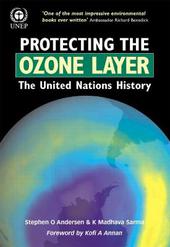
|
Protecting the Ozone Layer: The United Nations History
Hardback
Main Details
| Title |
Protecting the Ozone Layer: The United Nations History
|
| Authors and Contributors |
By (author) Stephen O. Andersen
|
|
By (author) K. Madhava Sarma
|
|
Foreword by Annan, Kofi
|
| Physical Properties |
| Format:Hardback | | Pages:544 | | Dimensions(mm): Height 234,Width 156 |
|
| Category/Genre | History of specific subjects
Global warming |
|---|
| ISBN/Barcode |
9781853839054
|
| Classifications | Dewey:363.73875 |
|---|
| Audience | | Undergraduate | | Postgraduate, Research & Scholarly | | Professional & Vocational | |
|---|
| Illustrations |
Figures, tables, index
|
|
Publishing Details |
| Publisher |
Taylor & Francis Ltd
|
| Imprint |
Earthscan Ltd
|
| Publication Date |
1 August 2002 |
| Publication Country |
United Kingdom
|
Description
In the 1970s the world became aware of a huge danger: the destruction of the stratospheric ozone layer by CFCs escaping into the atmosphere, and the damage this could do to human health and the food chain. So great was the threat that by 1987 the UN had succeeded in coordinating an international treaty to phase out emissions; which, over the following 15 years has been implemented. It has been hailed as an outstanding success. It needed the participation of all the parties: governments, industry, scientists, campaigners, NGOs and the media, and is a model for future treaties. This volume provides the authoritative and comprehensive history of the whole process from the earliest warning signs to the present. It is an invaluable record for all those involved and a necessary reference for future negotiations to a wide range of scholars, students and professionals.
Author Biography
Stephen O Anderson is a Director of Strategic projects in the US Environmental Protection Agency (EPA) Climate Protection Partnerships Division and a Co-chair of the Montreal Protocol Technology and Economic Assessment Panel. He was formerly Deputy Director of the EPA Stratospheric Protection Division where he specialized in industry partnerships, international cooperation and market incentives. Prior to that he was a professor of environmental economics at the College of the Atlantic and the University of Hawaii and a visiting scholar at Kyoto University. He also worked for consumer, environmental organizations. He has a PhD from the University of California, Berkeley K Madhava Sarma recently retired after working for the United Nations Environment Programme for more than Nine years as the Executive Secretary of the Secretariat for the Vienna Convention and the Montreal protocol, the ozone protection treatise. He has been associated with all the major developments of the treatise and assisted the governments in their efforts to protect the ozone layer. Previously, he held senior positions in the government of India and helped articulate the developing country positions on global environmental issues. He has vast experience in working on environmental issues in India
Reviews'One of the most impressive environmental books ever written.' Ambassador Richard Benedick, US Negotiator to the Montreal Protocol and author of Ozone Diplomacy '[An] outstanding historical account.' European Environment 'The remarkable story of how all countries - rich and poor, capitalist and communist, North and South - joined together against a common enemy: environmental destruction.' Mostafa K Tolba, Under-Secretary-General, United Nations, and Executive Director, United Nations Environment Programme, 1976-1992 'The strength of this book is its comprehensive character, written by two experts. The result is a book that is unique in its documentation and contains the most interesting insights.' International Journal of Sustainable Development 'The book is brought to life by personal perspectives. Here, some of the leading players - politicians, scientists, industrialists and environmentalists - give their own view of events.' Times Higher Education Supplement 'Sarma and Anderson's book is full of wonderful vignettes that demonstrate the creativity and dedication of government scientists and civil servants who worked for over a decade to create a workable global environmental management regime.' Nature
|